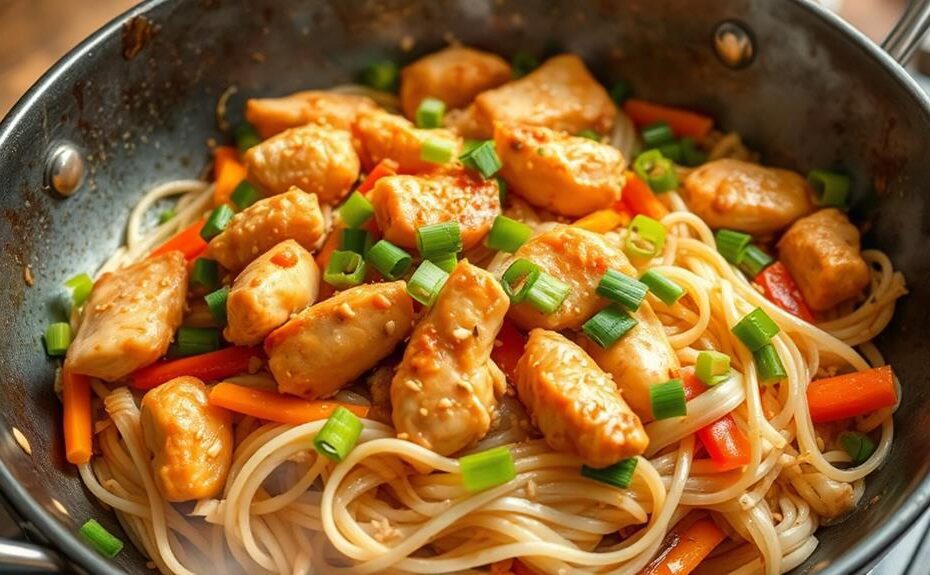Choose the Right Noodles
To make authentic Chicken Pancit Bihon, you need to start with the correct type of noodles. Bihon noodles made from rice flour and water provide a lighter texture compared to egg noodles. Soak them in warm water for 30 minutes to achieve tenderness.
Prepare the Chicken
To prepare the chicken, boil it in water, then shred and season it with salt, pepper, and soy sauce.
Create a Flavorful Base
Sauté aromatics like garlic and onions to create a flavorful base.
Then, cook the chicken and vegetables, adding soy sauce and reserved cooking water for added flavor.
Choose the Right Noodles
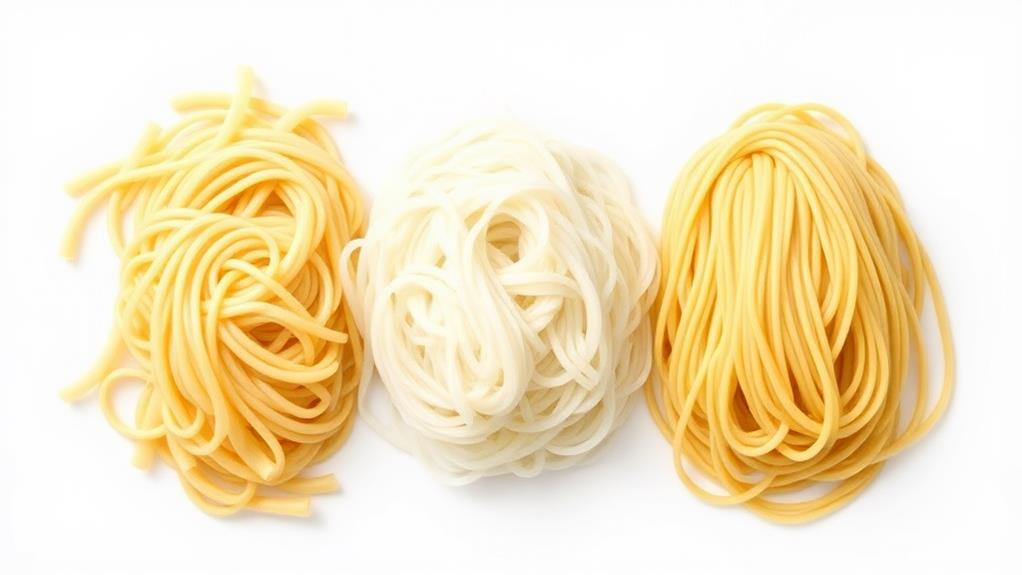
Choosing the Right Noodles for Chicken Pancit Bihon
Selecting bihon noodles is crucial for making authentic Chicken Pancit Bihon. These thin rice vermicelli, made from rice flour and water, are known for their slippery texture and ability to absorb flavors well.
To prepare bihon noodles, soak them in warm water for about 30 minutes to soften them, ensuring they'll be tender and easy to stir-fry.
Bihon noodles provide a lighter texture compared to Pancit Canton, which uses egg noodles, making them ideal for those who prefer a less chewy noodle.
You can find bihon noodles at Asian markets or in the international aisle of grocery stores, where they're often sold in dried form, packaged for convenience.
When selecting noodles, check for freshness and avoid packages with broken or discolored noodles to ensure the best quality for your Pancit Bihon dish.
Prepare the Chicken
Prepare the Chicken
To prepare the chicken for Chicken Pancit Bihon, start by boiling 6 cups of water in a pot.
Add chicken leg quarters or breast slices to the pot and cook for about 30 minutes until they're fully cooked and tender. If using frozen chicken, thaw it completely before boiling to achieve even cooking and tender meat texture.
Cool and Shred the Chicken
Once the chicken is boiled, remove it from the pot and let it cool.
Reserve the cooking water, as it serves as a flavorful chicken stock for the dish.
Shred the cooled chicken into bite-sized pieces using two forks or your hands, ensuring to remove any skin or bones in the process.
Season the Shredded Chicken
For enhanced flavor, season the shredded chicken with a pinch of salt, pepper, and a drizzle of soy sauce before incorporating it into the pancit.
Soak the Bihon Noodles
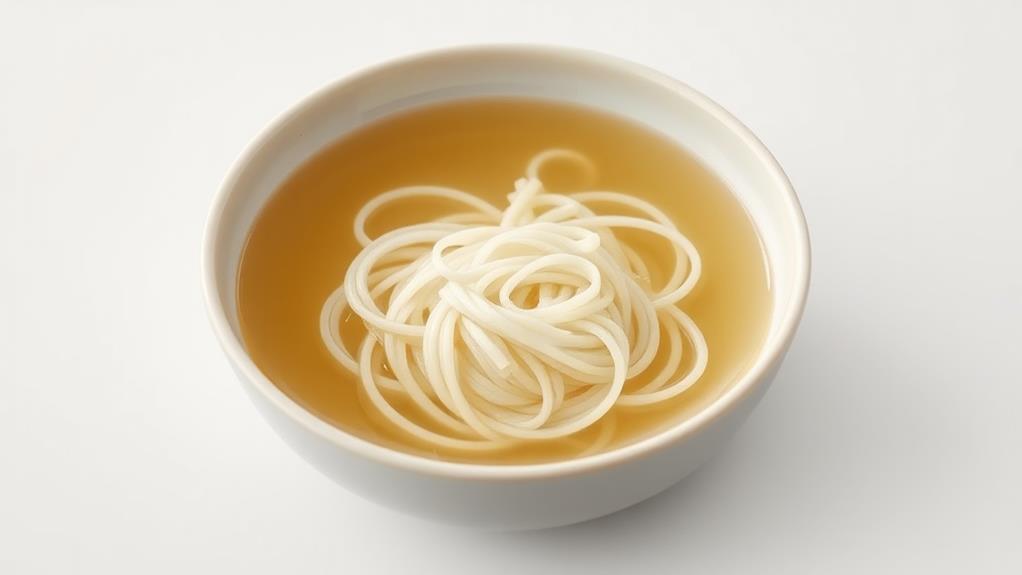
Soaking Bihon Noodles is Crucial for Perfect Texture
To achieve the right texture in Chicken Pancit Bihon, soak bihon noodles in warm water for approximately 30 minutes. This allows the thin rice noodles to become soft and pliable.
Avoid using boiling water, as it can make the noodles mushy.
Alternatively, soak the noodles in cold water for at least 1 hour to achieve the desired texture.
After soaking, drain the noodles thoroughly to remove excess water before adding them to the stir-fry. This step is crucial, as any remaining water can affect the overall consistency of the dish.
Proper soaking enables the noodles to absorb flavors during cooking, which is essential for a delicious Chicken Pancit Bihon.
The key to achieving the perfect texture lies in the soaking process.
Sauté the Aromatics
Heat two tablespoons of oil in a wok or large skillet over medium heat to ensure even cooking of the aromatics.
Add the minced garlic and chopped onions to the pan. Sauté them for 2-3 minutes until they become fragrant and the onions turn translucent.
Stir continuously to prevent the garlic from burning, which can impart a bitter taste to the dish. This sautéing process enhances the overall flavor and serves as the flavor base for the subsequent ingredients added to the pancit.
Properly sautéed aromatics lay the groundwork for a delicious Chicken Pancit Bihon, providing depth and richness to the final dish.
This step is crucial in building the flavor profile of your dish, so take your time and don't rush it.
Cook the Chicken and Vegetables
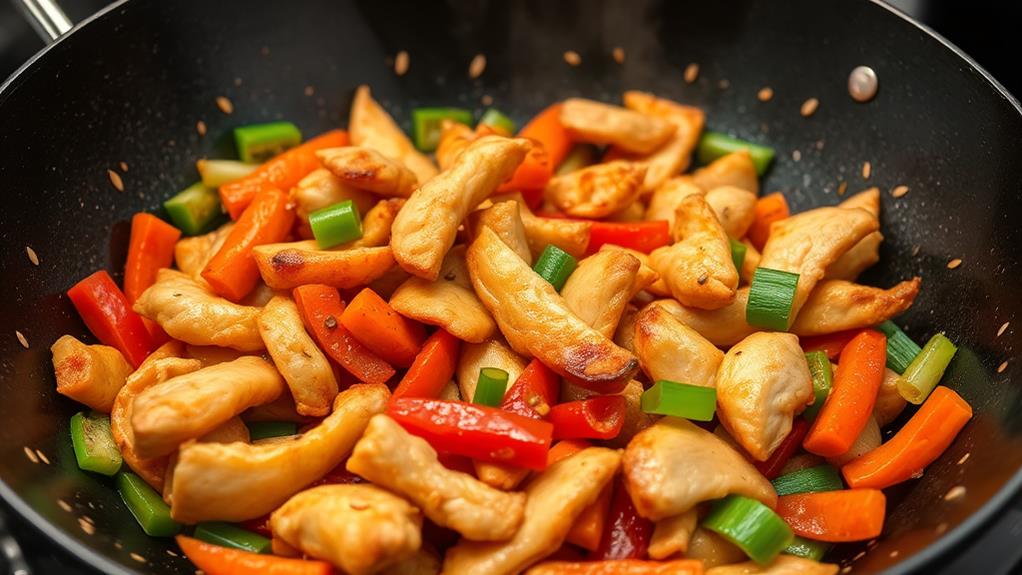
Cook the Chicken
To create a flavorful broth for Chicken Pancit Bihon, cook 6 cups of water with chicken for 30 minutes, or until it's fully cooked. This step is crucial in achieving a rich and savory dish.
Once cooked, shred the chicken and reserve the cooking water for later use as stock to enhance the dish's flavor.
Prepare the Noodles and Vegetables
While the chicken is boiling, soak the bihon noodles in water for 10-30 minutes until they're tender but not overly soft.
In a separate pan, sauté garlic and onion in oil until fragrant, then add the shredded chicken and cook until heated through.
Next, add julienned vegetables, such as carrots and shredded cabbage, and stir-fry them briefly until they're tender but still crisp, maintaining their vibrant color. This step adds texture and flavor to the dish.
Add Soy Sauce and Noodles
Combine Soy Sauce and Noodles
With your chicken and vegetables cooked, it's time to add the soy sauce and noodles to the dish. This step brings all the flavors together and creates a savory pancit bihon recipe.
Add Soy Sauce and Seasonings
Mix in 5 tablespoons of soy sauce and any additional seasonings, such as oyster sauce, to enhance the flavor profile of the dish.
Add and Distribute Noodles
Drain the soaked bihon noodles and add them to the wok, ensuring they're evenly distributed among the meat and vegetables for consistent flavor.
Toss and Combine Ingredients
Toss the noodles gently to combine all ingredients, allowing them to absorb the soy sauce and other seasonings as they cook together.
Stir-Fry and Heat Through
Stir-fry over medium-high heat for about 3-5 minutes until the noodles are heated through and have absorbed the sauce, being careful not to overcook them to maintain their texture.
As you stir-fry, the aromas of soy sauce, chicken, and vegetables will meld together, creating a rich and savory flavor profile.
The noodles will absorb the sauce, and the dish will start to come together.
Mix and Cook Thoroughly
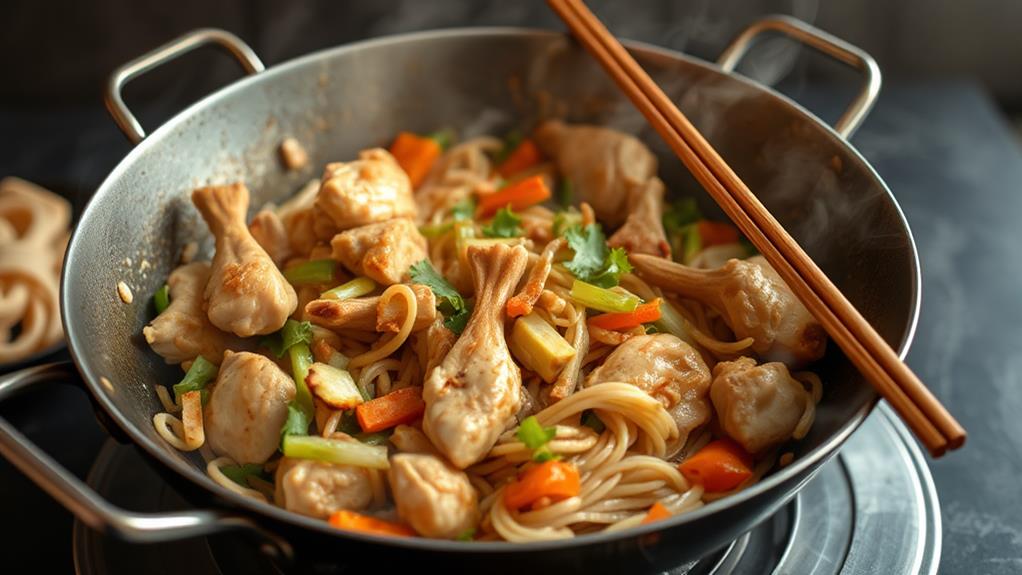
To achieve a harmonious balance of flavors and textures, mix and cook the ingredients thoroughly.
Start by ensuring the soaked bihon noodles are drained well to prevent excess moisture from making the dish soggy. Then, mix the cooked chicken with sautéed garlic and onions to infuse the flavors. This step allows the chicken to absorb the flavors of the garlic and onions, creating a rich and savory taste.
Add vegetables in stages to achieve optimal texture and flavor balance.
Add the vegetables, such as carrots and cabbage, to the pan in stages, allowing each type to cook down slightly before adding the next. This ensures that each vegetable is cooked to the right texture and flavor.
Coat the noodles evenly with the combined sauces.
Pour the combined sauces (soy sauce and oyster sauce) evenly over the noodles and stir-fry at medium heat, ensuring the noodles are thoroughly coated and heated through. This step distributes the flavors of the sauces evenly throughout the dish.
Toss everything together to ensure flavors are evenly distributed.
Toss everything together vigorously in the pan for about 3-5 minutes, allowing the noodles to absorb the flavors and ensuring all ingredients are evenly distributed throughout the dish. This crucial step results in a dish with optimal texture and flavors that are evenly distributed.
Season to Taste
Achieving Balance in Flavor
Seasoning Guidelines for Chicken Pancit Bihon
To perfect the flavor of Chicken Pancit Bihon, it's crucial to balance the seasoning.
The goal is to harmonize flavors without overpowering the dish.
Soy Sauce: Gradual Addition
Add soy sauce gradually during cooking, tasting frequently to achieve the desired saltiness.
Oyster Sauce: Balancing Sweetness and Depth
Incorporate oyster sauce to add a hint of sweetness and depth, balancing the savory flavor of soy sauce.
Black Pepper: Enhancing the Taste
Use freshly ground black pepper to enhance the overall taste, providing a subtle kick without overwhelming other flavors.
Calamansi or Lemon Juice: Bright Finishing Touch
Consider adding a splash of calamansi or lemon juice at the end for a bright, zesty finish that complements the richness of the dish.
Chicken Bouillon Powder: Intensifying Flavor
Experiment with chicken bouillon powder to intensify the flavor, but use it sparingly to avoid making the dish too salty.
Serve and Enjoy

Serve and Enjoy
Once you've achieved the perfect balance of flavors, it's time to serve your Chicken Pancit Bihon.
Serve it hot, garnished with chopped green onions and lime or calamansi wedges for a refreshing contrast. Pair it with traditional sides like lumpiang shanghai (spring rolls) to create a well-rounded meal experience.
For added flavor, provide extra soy sauce or chili sauce on the side for those who enjoy a bit of spice.
Present the dish in a large, colorful serving platter to enhance its visual appeal, especially at gatherings and celebrations.
Remember that leftovers can be refrigerated in an airtight container and are best consumed within 2-3 days. When reheating, do so gently to maintain the dish's texture.
What Are the Essential Steps for Making Delicious Chicken Pancit Bihon at Home?
If you’re craving a delicious and easy-to-make Filipino dish, try this quick chicken pancit bihon recipe. Start by sautéing the chicken and vegetables, then add the bihon noodles and broth. Stir in soy sauce and seasonings, and garnish with green onions and calamansi. Enjoy the authentic flavors in every bite.
Store Leftovers Safely
Store Leftovers Safely
To prevent foodborne illness and maintain the quality of your leftovers, follow these steps:
Cool to Room Temperature
Allow the dish to cool down to room temperature before sealing it in an airtight container. This prevents condensation, which can lead to sogginess.
Refrigerate
Store the leftovers in an airtight container in the refrigerator, where they can last for up to 2-3 days.
Freeze
For longer storage, consider freezing the leftovers in a freezer-safe container, where they can last for up to 2 months without significant loss of flavor or texture.
Reheat Safely
When reheating, use a microwave covered with a damp towel to retain moisture, or reheat gently on the stovetop over low heat to prevent overcooking the noodles.
Check for Spoilage
Always check for any off smells or changes in texture before consuming stored leftovers, as these can indicate spoilage.
Frequently Asked Questions
How Do You Cook Pancit Canton Steps?
Choosing the Right Noodle Variety
Pancit Canton uses a thicker and chewier noodle variety compared to Bihon. This difference in noodle texture affects the overall cooking time and technique.
Mastering Cooking Techniques
To cook Pancit Canton, boil the noodles according to the package instructions until they're slightly undercooked.
Then, sauté the noodles in a pan with oil to add flavor and texture.
Finally, stir-fry the noodles with your chosen ingredients to combine the flavors.
Balancing Flavor Profiles
To achieve a balanced flavor, combine soy sauce, oyster sauce, and chicken broth in your stir-fry.
These ingredients provide a salty, savory, and umami flavor profile that complements the noodles.
Flexibility with Ingredients
Feel free to substitute ingredients based on your personal preferences.
For example, you can replace pork with shrimp or add vegetables like cabbage and carrots.
Prep Time and Health Benefits
Pancit Canton can be prepared in 20 minutes, making it a quick and easy meal option.
This dish also provides several health benefits due to its high vegetable content and lean protein sources.
Cultural Significance
Pancit Canton is a popular Filipino dish that holds cultural significance.
It's often served at special occasions and is a staple in many Filipino households.
What Is the English Name for Bihon?
The English name for "bihon" is rice vermicelli. These thin, delicate noodles are made from rice flour and water, giving them a slippery texture that's perfect for soaking up flavors.
Rice vermicelli noodles are often paired with savory ingredients like chicken marinade, soy sauce, and garlic flavor when cooking traditional recipes.
Their ability to absorb flavors makes them a great base for stir-fried dishes, offering numerous health benefits and regional variations to explore.
What Is the Difference Between Pancit and Bihon?
Pancit is a broad term that encompasses various Filipino noodle dishes. This term covers a range of noodle types, regional variations, and cooking techniques, which ultimately affect the flavor profiles and serving suggestions.
Bihon, on the other hand, specifically refers to a type of Pancit made with thin rice vermicelli noodles. This distinction in noodle type leads to differences in cooking techniques and flavor profiles.
For instance, Bihon noodles are typically cooked in a mixture of soy sauce, oil, and garlic, giving them a distinct savory flavor.
Understanding the nuances between Pancit and Bihon helps appreciate the cultural significance of these dishes in traditional recipes and meal pairings.
What Food Goes Well With Pancit Bihon?
Traditional Filipino dishes pair well with pancit bihon. Lumpiang shanghai and pinakbet are classic accompaniments that enhance the flavor profile of the noodles.
Refreshing sides complement the dish. Consider serving grilled meats or seafood, such as chicken or shrimp, for a complete meal.
Salads like a simple green salad or a tomato and onion salad also pair well with pancit bihon.
Add a burst of citrus flavor. Serving pancit bihon with calamansi or lemon wedges provides a zesty kick.
Choose a refreshing beverage. A glass of iced tea or fresh fruit juice, such as mango or pineapple, complements the noodles nicely.
